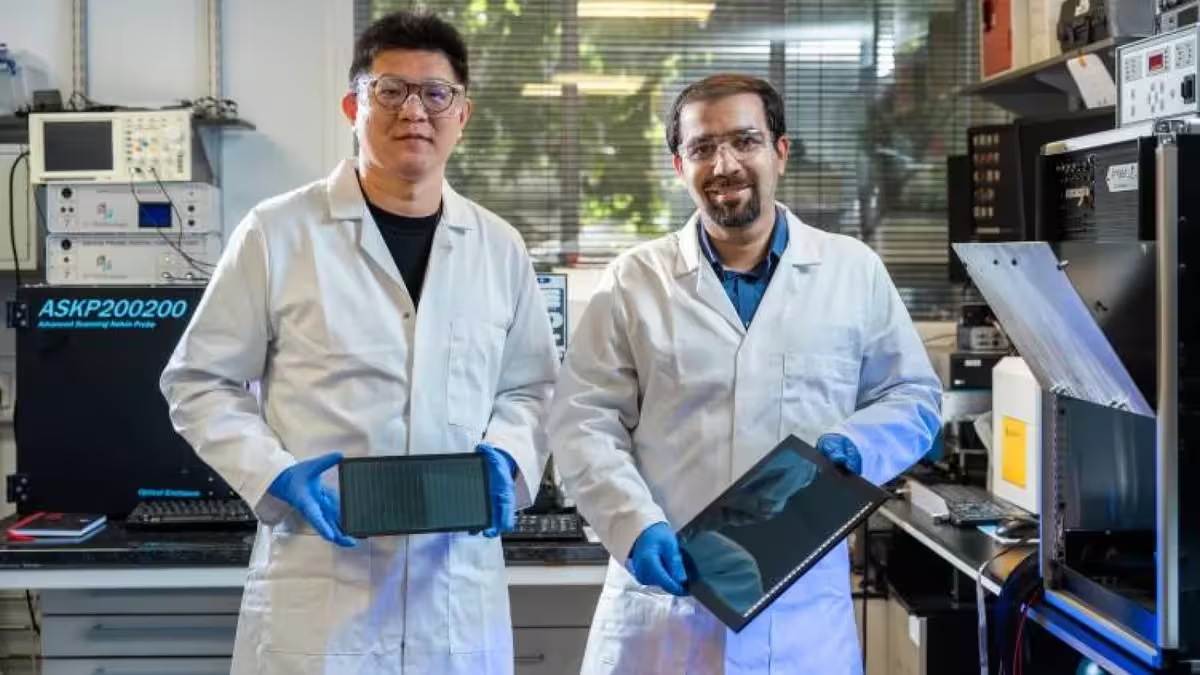6 Minutes
Perovskite cells that harvest indoor light could make many devices battery-free
Researchers have developed miniature perovskite solar cells able to convert ambient indoor light into usable electricity with substantially higher efficiency than conventional silicon-based indoor photovoltaics. Published April 30 in Advanced Functional Materials, the study demonstrates that tailored perovskite compositions can capture energy under typical office illumination and sustain performance over months, opening a possible pathway toward battery-free peripherals such as keyboards, alarms, wireless sensors and other low-power Internet of Things (IoT) devices.
Scientific background: why perovskite works indoors
Perovskites are a class of crystalline materials already under intense investigation for solar power because they absorb light effectively and can be manufactured using low-cost, solution-based processes. Unlike conventional silicon cells, which are optimized for strong sunlight, perovskite formulations can be tuned to absorb lower-intensity, diffuse light typical of indoor environments. The research team reports that their optimized perovskite cells achieved a power-conversion efficiency of 37.6% at 1,000 lux — roughly the illumination of a well-lit office — and were about six times more effective than equivalent silicon-based cells under the same indoor conditions.
Key materials and the performance challenge
One limitation of perovskite materials has been structural defects known as 'traps' — tiny imperfections in the crystal lattice where charge carriers (electrons or holes) become immobilized. Traps both reduce instantaneous electrical output and accelerate long-term degradation because they interrupt the smooth flow of charge through the material. To address these obstacles, the team modified the perovskite chemistry and processing to reduce trap density and stabilize ionic components that can migrate or segregate over time.
Experiment details and compositional strategies
To reduce defects and improve stability, the researchers introduced a combination of additives and surface treatments. Rubidium chloride was used to promote more uniform crystal growth, lowering the density of trap sites. Two organic ammonium salts — N,N-dimethyloctylammonium iodide (DMOAI) and phenethylammonium chloride (PEACl) — were applied to stabilize iodide and bromide ions in the perovskite lattice, preventing ion segregation that commonly leads to degradation. The authors describe these steps as restoring continuity in the material's charge-transport network, an effect they compare to reassembling a fragmented cake so electrical charge can pass through more freely.
After these chemical and processing optimizations, the devices retained 92% of their initial performance after 100 days of controlled testing. A control perovskite device without the defect-reduction measures retained only 76% of its initial output over the same period, demonstrating the stabilizing benefit of the new approach.

Implications for consumer electronics and IoT
Low-power electronics are a major and growing class of products that presently rely on disposable or rechargeable batteries. Study co-author Mojtaba Abdi Jalebi, associate professor in energy materials at University College London's Institute for Materials Discovery, notes that billions of small devices require frequent battery maintenance, a practice with rising environmental cost as IoT deployments expand. By enabling components to harvest energy from ambient indoor light, perovskite indoor photovoltaics could reduce battery waste, lower ownership costs and simplify device design.
The technology's potential advantages include low manufacturing cost, use of earth-abundant feedstocks and compatibility with printing-based production techniques similar to newspaper printing. The research team is already discussing scale-up and commercialization routes with industry partners to translate the lab results into viable products.
Related technologies and future prospects
Indoor energy harvesting complements other thin-film and nanoparticle approaches that aim to turn surfaces into small-scale power generators — from ultra-thin solar coatings for phone cases to nanoparticle-enhanced PV films for vehicles. Combining perovskite indoor cells with energy-efficient electronics, supercapacitors or micro energy storage could create self-sustaining devices that never require external battery swaps. Remaining hurdles include long-term stability under real-world conditions (temperature swings, humidity, mechanical stress) and safe, scalable manufacturing that controls toxic or volatile precursors.
Expert Insight
Dr. Elena Vasquez, a materials scientist at a major research institute, commented on the study's significance: 'Achieving near-40% efficiency under typical indoor lighting is a notable milestone. The combination of defect passivation and ion stabilization implemented here addresses two of the most persistent weaknesses of perovskites: charge trapping and ionic migration. That said, demonstrating multi-year reliability in everyday environments will be the decisive next step before we can expect widespread adoption in consumer electronics.'
Practical considerations and next steps
Even with promising lab results, several translational steps remain. Device packaging must protect perovskite layers from moisture and mechanical damage while keeping costs low. Manufacturers will need to evaluate lifecycle impacts compared with current battery supplies and recycling pathways. The research team plans to optimize scalable deposition techniques and pursue industry partnerships to pilot modules for real-world trials in homes and offices.
Conclusion
The new perovskite indoor solar cells demonstrate a credible route to powering small electronics using ambient room light. By reducing trap-related defects and stabilizing ionic components, researchers have significantly improved both efficiency and short-term durability, achieving 37.6% conversion at 1,000 lux and 92% retention after 100 days. If manufacturers can scale production and validate long-term reliability, perovskite-based indoor photovoltaics could become a practical, low-cost solution to reduce battery dependence across a wide array of IoT and household devices.
Source: livescience


Leave a Comment